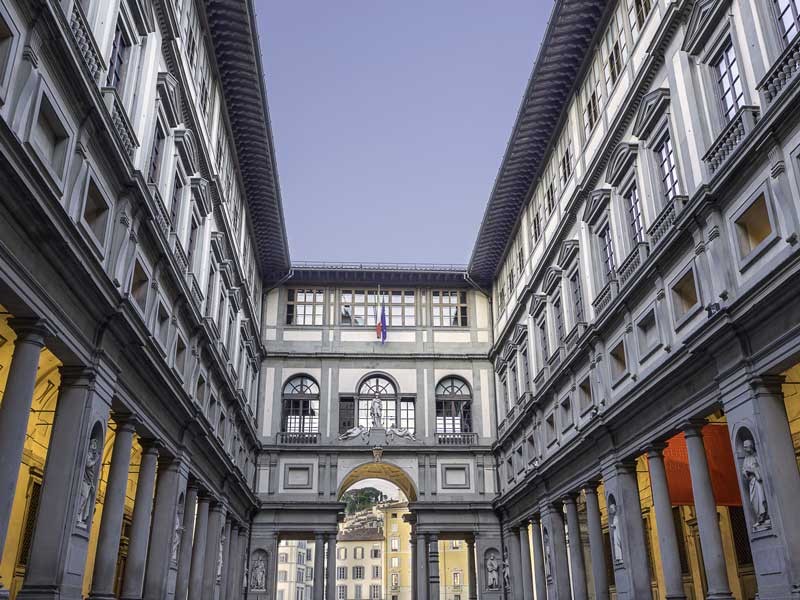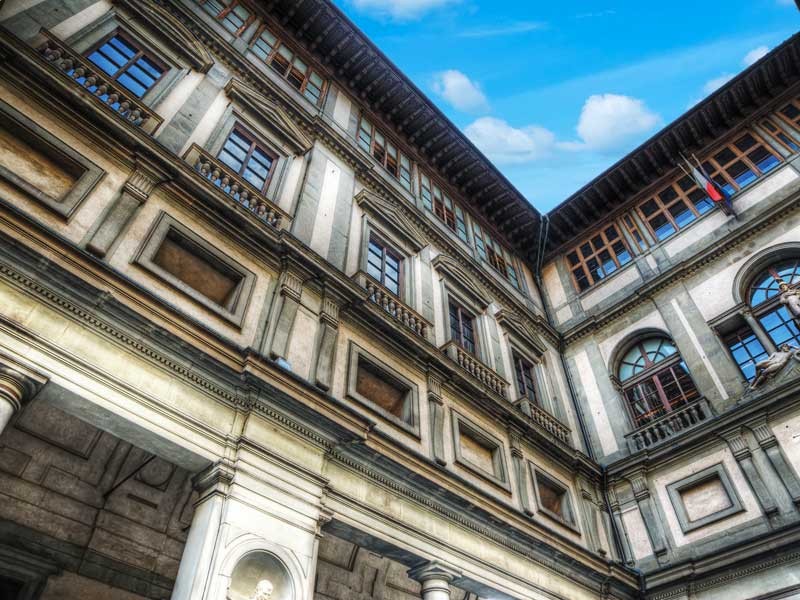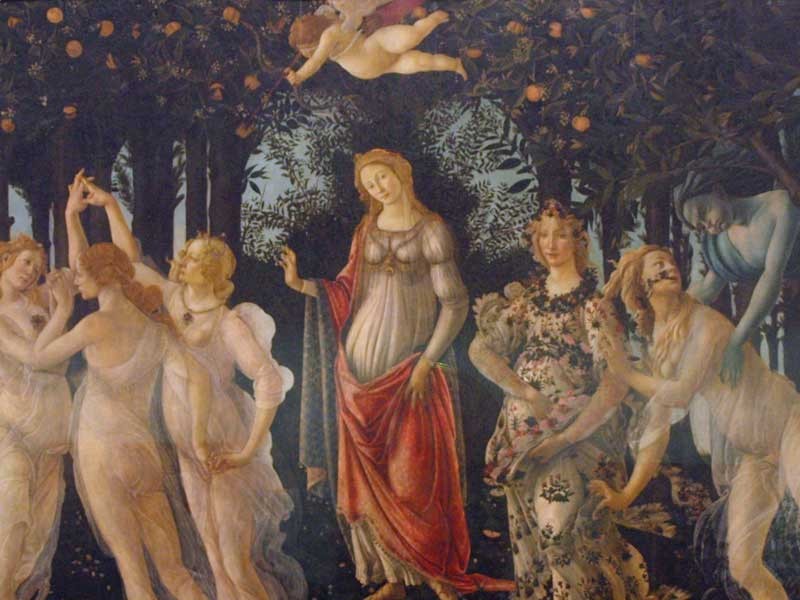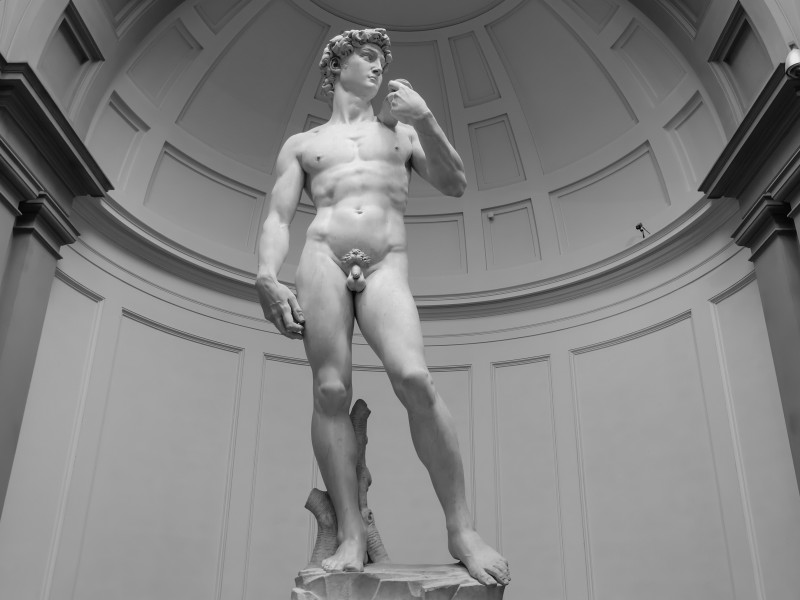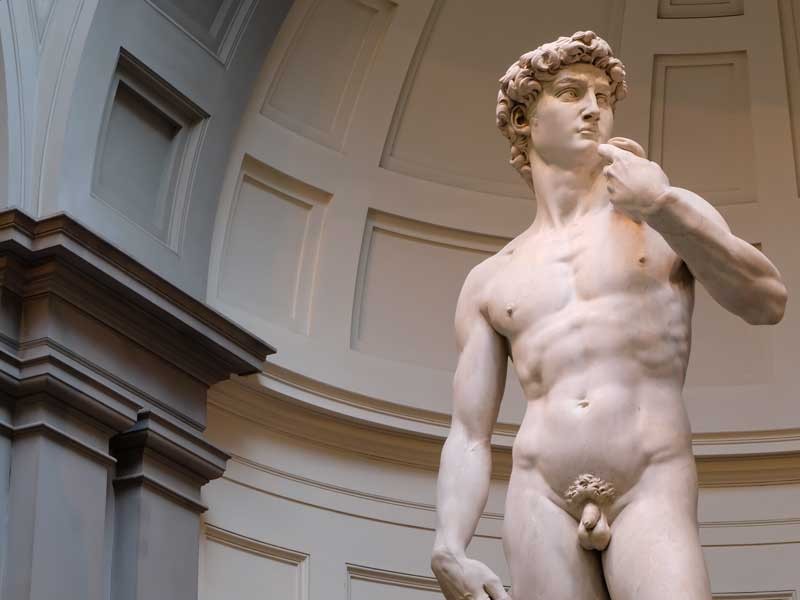Combo ticket Uffizi Gallery and Accademia Gallery: reserve your tickets for the two main museums of Florence and visit them without queuing up and SAVE 10%! Do not waste your precious vacation time! Buy now tickets online through our easy system and you will have fast access to masterpieces as Botticelli's Spring at the Uffizi Gallery and Michelangelo's David at the Accademia Gallery
Info & Booking
Combo package Uffizi Gallery and Accademia Gallery: visit both museums on the same date and save 10%!
Choose from the calendar your preferred time for the Uffizi Gallery, 9:00, 11:00, 15:00 or 16:45; we will confirm the closest available time on the same date, booking also the entrance to the Accademia Gallery, in the opposite half of the same day (according to availability).
Rules of conduct
- The ticket must be kept for the duration of the visit.
- Please note that for safety reasons access is granted after checking through the metal detector where knives and/or objects will be retained if they are considered dangerous. It is also forbidden to enter the gallery armed (even if equipped with a regular weapons license).
- No animals of any kind are allowed, with the exception of guide dogs for the blind, service dogs for assistance to the disabled and domestic support animals for therapeutic treatment (pet therapy) with certifications issued by physicians of public health facilities.
- Visitors who are less than 12 years old must be accompanied by an adult.
- Because the gallery does not provide wardrobe services, visitors are not allowed access carrying luggage, large backpacks, helmets, and any other bulky object greater than 40x30x18 cm.
- Mobile phones must be switched off or at least put in silent mode.
The following activities are prohibited inside the gallery:
- Smoking (including electronic cigarettes)
- Flash photography, as well as using a selfie stick and tripod or bulky equipment
- Introducing beverages of any kind (including cans or glass bottles) except water in plastic bottles in quantities not exceeding 0.5 l
- Consuming food throughout the museum route
- Sitting on floors or stairs
- Introducing non-resealable umbrellas that must be deposited in the umbrella holders
- Conduct that endangers the safety of works or other visitors
- Touching artworks or bringing objects that could damage them
- Writing or drawing on the walls
- Drawing using watercolors, markers, chalk or other materials except for pencils or digital media
- Leaving waste anywhere but in the specially provided containers present at the bookshop and at the exit
- Leaning on the pedestals of the sculptures and on the walls, standing on benches and chairs
- Running in museum environments
- Screaming or using a loud tone of voice
- Not respecting the museum signs and the indications of the staff
- Wearing inappropriate clothing (such as swimsuits, skimpy clothes, etc.)
- Being shirtless or barefoot
- Displaying inappropriate behavior (such as combing oneself or putting on makeup, changing shoes, changing diapers of children, etc.)
In each room, there is a museum assistant, identifiable by tag and uniform, which is responsible for enforcing this regulation and the safety of the exhibited works and of the people present. If necessary, the supervisory staff is allowed to intervene and remove those who, with their behavior, endanger the safety of the works or disturb the other visitors.
Behavior in case of an emergency:
In case of alarm and/or emergency, visitors must follow the signs and indications of the staff of the room. In case of evacuation, all visitors must proceed in an orderly way, following the instructions of the staff.
Prices
Full Price
Reduced Price:
European Union citizens aged 18 to 25
Free tickets:
Children under 18 years old from any country
Children under 12 (must be accompanied by an adult)
Tourist guides and interpreters (accompanying a group), with official documentation
ICOM members
Students/scholars of all nationalities may apply for special research permits for a limited period.
Free admission the first Sunday of every month
Schools:
Italian and European school groups accompanied by their teachers, with official authorization from the school and with an advance booking made directly with the museum.
PLEASE NOTE:
Service fees (pre-sale and online booking fees), as well as fees for temporary exhibitions happening during your visit are due for ANY KIND OF TICKET as well as for free admission days.
When picking up a reduced or free ticket, you will be asked for a document proving your right to the price reduction. Entrance will be denied without it.
Before You Book
PLEASE NOTE: Immediately after submitting an order, you will receive two email. The first email contains your order summary (this one you receive immediately after placing your order), the second email confirms your successful payment (one business day after placing the order). In order to receive these two emails, please make sure that you enter your email address correctly and check that antispam or antivirus filters do not block emails from our [email protected] address. Users of AOL, Comcast and Sbcglobal.net need to pay special attention to this, please. Vouchers will also be available, one business day after the request, at your dashboard.
IMPORTANT NOTE: The time you select on the order form is your preferred time. The closest available time, which can be anytime during opening hours on the selected date, will be automatically confirmed if your preferred time is no longer available.
Cancellation Policy
Once a confirmation code has been assigned to your reservation, we can refund the cost of unused tickets, also for no-shows, minus a service fee (reservation fee and online booking fee).
Price categories
Full Price
Reduced Price:
European Union citizens aged 18 to 25
Free tickets:
Children under 18 years old from any country
Children under 12 (must be accompanied by an adult)
Tourist guides and interpreters (accompanying a group), with official documentation
ICOM members
Students/scholars of all nationalities may apply for special research permits for a limited period.
Free admission the first Sunday of every month
Schools:
Italian and European school groups accompanied by their teachers, with official authorization from the school and with an advance booking made directly with the museum.
PLEASE NOTE:
Service fees (pre-sale and online booking fees), as well as fees for temporary exhibitions happening during your visit are due for ANY KIND OF TICKET as well as for free admission days.
When picking up a reduced or free ticket, you will be asked for a document proving your right to the price reduction. Entrance will be denied without it.
Audio guides rental service
Make the most of your visit to the Accademia Gallery – book your Accademia Gallery audio guide, after choosing the date, time, and number of tickets for your visit to the Accademia Gallery! The Accademia Gallery is one of the richest museums in the world, with some of the greatest artistic treasures of mankind on view. Make sure you don't miss important works of art, and supplement what you know with the audio guide's insightful commentary.
Audio guides are available in Italian, English, French, German, and Spanish.
The audio guided visit has a complete duration of 75 minutes and includes a selection of the most important works of art in the Gallery. To learn more about the works of art on view, choose the desired room and listen to the explanation of selected works in that room.
You will receive a confirmation voucher (valid only for the audio guide) together with the confirmation voucher for your visit to the museum. In order to pick up the audio guide, please deposit this voucher at the Audio Guides Desk – at the bookshop opposite the ticket booth – along with a valid identity document (passports, identity cards or driver's license – only originals are accepted).
In case of loss or failure to return the audio guide, visitors will be requested to pay the cost (€ 250.00 per each audio guide).
OPENING HOURS
Tuesday to Sunday: 8:15 to 18:50; closed on Monday.
Extraordinary night openings:
- every Tuesday and Thursday from June 4 to September 26, from 7pm to 10pm (last bookable admission bookable: 8:30pm)
RULES OF CONDUCT
The following actions are forbidden: Touching the artwork Leaning on the bases of the sculptures or the walls Smoking Throwing chewing gum on the floor or sticking it anywhere else Consuming food and beverages Sitting on the floor and on the protection barriers Speaking loudly Behaving in any way that does not respect the dignity of the place Bringing backpacks and umbrellas - on rainy days it is advisable to carry only small umbrellas Using your mobile phone Using the telescopic extender to take photographs (selfie stick) Using laser pointers
Uffizi Gallery and Accademia Gallery
THE UFFIZI GALLERY
The Palace:
The Uffizi Palace was commissioned by Cosimo I de\' Medici and designed by Vasari (16th Century). Many buildings were demolished to make space for building the new palace, with the most important being the church of San Piero Scheraggio.
Cosimo I de\' Medici required the new palace to host the offices of thirteen administrative and judicial magistrates. During the construction of the building, Vasari died and was succeeded by Buontalenti and Alfonso Parigi. They first designed the Teatro Mediceo (Medici Theater), as requested by Francesco I, son of Cosimo I, in 1586. This space became the seat of Italy\'s Senate when Florence was the capital of Italy in the 19th century.
The Uffizi Palace has an unusual ‘U’ shape, open towards the Arno: two wings of the palace are connected by a corridor with six big arched windows facing the Arno and the inner courtyard. Statues of famous citizens of Florence from the Middle Ages to the 19th Century fill the niches of the portico arcades supporting the two floors of the building.
Nowadays the building hosts the Uffizi Gallery, one of the most visited museums in the world, with masterpieces from the 13th to the 18th century.
In 1993 a bomb at the Accademia dei Georgofili caused major damage to some masterpieces of the Uffizi Gallery. Most of these works of art have been restored to their original splendor and are again accessible to the public.
The Gallery:
Francesco I de\' Medici created an art gallery on the second floor of the Palazzo degli Uffizi for his personal enjoyment. The collection became “public and inalienable good” thanks to Duchess Anna Maria Luisa de\' Medici who handed it over to the Lorena family providing that it would remain open to the public.
Today, the Uffizi Gallery is one of the most important museums in the world The collection keeps growing, thanks in part to artworks commissioned by the corporations of arts and crafts. Through their economic, cultural and artistic exchanges, Florence has become the world capital of art and a point of meeting and exchange for important Italian and foreign artists. Other additions to the Uffizi Gallery come from private donations, diplomatic exchanges, from convents and dynastic legacies.
The entrance to the Uffizi Gallery is located under the left portico. After the ticket office you access the Aula di San Piero Scheraggio, the still existing central aisle of the church, which was destroyed to widen Via della Ninna. It is now a richly decorated exhibition space with Medieval and Roman art works. Note the historical-religious frescoes by Andrea del Castagno.
From the Uffizi Gallery ticket office you enter the Monumental Staircase by Vasari, which leads you to the first floor. From the big hall you pass on to the exhibition and reference room of the Drawings and Prints Cabinet. This vast collection contains drawings by artists such as Leonardo da Vinci, Michelangelo, Pontormo, Vasari and others. The collection, among the greatest and most important in the world, was started by the will of Lorenzo de\' Medici and continued by his followers. Today, the Drawing and Prints Cabinet can only be visited for research reasons. After the Drawing and Prints Cabinet there is the Library and areas reserved for temporary exhibits. The Uffizi Gallery itself is located on the second floor.
Uffizi Gallery - The first corridor:
The entrance hall to the Uffizi Gallery hosts Roman sculptures (plaster moulds and copies) belonging to the Medicean collection.
The first corridor, also called \'eastern corridor\', is dedicated to examples of sacred art including art of the Renaissance and works by Flemish artists illustrating the strong connection between art and spirituality. The first corridor gives access to the rooms with artworks belonging to the 13th-16th centuries. Along the perimeter of the corridor the Medicean collection of head moulds and sculptures are placed at regular intervals. The vaults are decorated with frescoes representing animals, imaginary monsters, satyrs, and Medicean achievements. Portraits of famous men and rulers from all over the world are placed under the arches.
The first rooms are dedicated to the art of the 13th and 14th centuries. Here we find examples of sacred art including the Madonna d\'Ognissanti by Giotto, the Maestà di Santa Trinita by Cimabue and the Maestà by Duccio di Buoninsegna. the Triptych of San Matteo by Andrea di Cione, the Polyptych of San Pancrazio by Bernardo Daddi and the Presentation in the Temple by Ambrogio Lorenzetti (rooms 3-4) plus works from 14th century Florence and Siena.
Rooms 5-6 are dedicated to the international Gothic, including The Adoration of the Magi by Lorenzo Monaco. Among the artworks of the early Renaissance are The Coronation of the Blessed Virgin by Beato Angelico, The Battle of San Romano by Paolo Uccello, Portrait of the Dukes of Urbino by Piero della Francesca (room 7). In rooms 8 and 9 are artworks by artists such as Filippo Lippi: The Coronation of the Blessed Virgin, The Adoration of the Magi, and by Antonio del Pollaiolo: A Female Portrait, Hercules and Antes. Room 10 hosts masterpieces by Botticelli: The Slander, Primavera, The Birth of Venus, Adoration of the Magi, Madonna della Melograna,and Coronation of the Blessed Virgin.
The Renaissance is celebrated with paintings by Leonardo da Vinci, including L\'Adorazione dei Magi, the Annunciation, and Perugino\'s Pietà, (room 15). Sixteenth century Florence is represented in the Tribuna with Medicean portraits by Pontormo, with Rosso Fiorentino\'s L\'Angiolino musicante and Andrea del Sarto\'s La Dama col Petrarchino. In a series of adjoining rooms are works belonging to German art of the 15th and 16th century and paintings evoking mythological tales from Lombardia and Emilia, as well as detailed Flemish landscapes (rooms 19-23). Among these are Adam and Eve by Lukas Cranach, Adoration of the Magi by Andrea Mantegna, The Blessed Virgin adoring the Child by Correggio.
Uffizi Gallery - The second corridor:
The second corridor, also called \'midday corridor\', is certainly one of the most enthralling places of the whole Palazzo degli Uffizi. It is the connecting corridor between the two wings of the horseshoe-shaped palace. Enjoy the picturesque beauty and elegance of Florence through the high windows: the Ponte Vecchio, the Vasari Corridor, the Arno River, the more distant hills. The vaults are decorated with precious grotesque frescoes, among them a painting representing a pergola with birds, flowers and plants and the Virtues of the Medicean Grand Dukes by Nasini.
The Miniature Cabinet is the only room connected to this corridor. It was originally called Camera degli Idoli (Room of the Idols) and later Camera di Madama (Madam Room) since it first hosted a collection of bronze statues and then the jewels of Cristina di Lorena. The vault is decorated with an Allegory of Fame by Filippo Lucci. The oval room holds around 400 miniature portraits, most of which come from the collection of Leopoldo de\' Medici. The floor is very characteristic: the inlaid marble creates the image of a big carpet. Portraits of rulers from all over the world are placed under the frescoed vaults along the entire corridor. Among the numerous sculptures from the Roman age is a delicate representation of Amor and Psyche.
Uffizi Gallery - The third corridor:
The third corridor is also known as the \'western corridor\'. Sixteenth century artworks by great artists such as Michelangelo, Raffaello Sanzio and Rosso Fiorentino open the collections of the third corridor. Like the two previous ones, the third corridor has frescoed vaults with grotesques depicting animals, famous personalities, and Medicean achievements. Here, too, are portraits of the \'Jovian series\' with royalties from all around the world and Roman statues
The museum visit continues with rooms 25-27, which host the work of Florentine painters of the 16th century. These include Michelangelo Buonarroti\'s Tondo Doni or Sacra Famiglia con San Giovannino, Ridolfo del Ghirlandaio’s La Coperta di Ritratto, Raffaello Sanzio’s La Madonna del Cardellino, Andrea del Sarto’s La Madonna delle Arpie, Pontormo’s Cena in Emmaus, Rosso Fiorentino’s La Madonna col Bambino e Santi, and artworks that introduce a dramatic mannerism. Tiziano is represented as the most illustrious of 16th century Venetian artists (room 28) with La Venere d\'Urbino, and Flora.
Among the examples of Italian painting in Europe in the 16th century (rooms 29-34) are Tintoretto\'s Leda e il Cigno (Leda and the Swan), Parmigianino\'s Madonna dal Collo Lungo (Madonna with the Long Neck), and Giorgio Vasari\'s La Fucina di Vulcano (The Furnace of Volcano). The 17th century is represented with Rubens\' Portrait of Isabella Brandt and Diego Velasquez\' Filippo IV of Spain riding a Horse. The following room (42) is named after queen Niobe, with sculptures based on the mythological theme portraying Niobe trying to protect her children from the deadly rage of Apollo and Diana.
The final rooms are dedicated to paintings from the 17th century. Caravaggio is represented with his Bacchus, The Sacrifice of Isaac and Medusa. Rooms 44 and 45 give access to works by Rembrandt and the Venetian views by Canaletto, among others. The entrance to the bar and to the terrace of the Uffizi Gallery is located next to the final room. From the terrace, you can admire architectural masterpieces such as Arnolfo di Cambio\'s tower of the Duomo Santa Maria del Fiore with the Cupola by Brunelleschi.
THE ACCADEMIA GALLERY:
Located in the heart of the city, the Accademia Gallery hosts examples of paintings and sculptures by the great 14th and 15th century masters who made Florence the capital of art.
Founded in 1784 upon Grand Duke Leopoldo of Lorena\'s decree, La Galleria dell\'Accademia was created to host a collection of antique and modern paintings and sculptures so the students of the nearby Accademia di Belle Arti could pursue their studies in the light of these great masterworks. The Accademia Gallery is situated in parts of the former convent San Niccolò in Cafaggio and the hospice of San Matteo.
In 1873 Michelangelo\'s David was transferred here to save it from the erosion of time and weather. In 1882 will Michelangelo\'s masterpiece was placed in the Tribuna del David specially created by Emilio de\' Fabris.
Through time the Accademia Gallery has become famous for its collection of sculptures by Michelangelo. The collection is enriched by paintings and sculptures by other artists who made Florence into one of the most important capitals of art. Around 1980, a Gipsoteca (collection of sculptures), located in the Salone dell\'Ottocento (19th century hall), was added to the Accademia Gallery. The Accademia Gallery is situated on two floors of which the ground floor is certainly the most famous and admired.
The Accademia Gallery visit begins with the Sala dell\'Anticolosso, where the gesso original of The Rape of the Sabines (1582) by Giambologna is placed. Paintings such as Cristo in Pietà by Andrea del Sarto and the Deposition of the Cross by Filippo Lippi can be seen here. From here you reach the Galleria dei Prigioni, a corridor that hosts a series of incomplete sculptures by Michelangelo. The visitor is invited to experience the emotional impact of these sculptures that seemingly burst forth from the stone, liberated by the hand of the great artist. Among these sculptures note the famous Pietà da Palestrina, which arrived at the Accademia Gallery in 1940. The art work seems disproportionate in its dimensions, so much so that the ascription to Michelangelo is uncertain.
Audio guides rental service Uffizi Gallery
Make the most of your visit to the Uffizi Gallery – book your Uffizi Gallery audio guide, after choosing the date, time, and number of tickets for your visit to the Uffizi Gallery! The Uffizi Gallery is one of the richest museums in the world, with some of the greatest artistic treasures of mankind on view. Make sure you don't miss important works of art, and supplement what you know with the audio guide's insightful commentary.
Audio guides are available in Italian, English, French, German, Spanish, Russian, and Japanese.
The audio guided visit has a complete duration of 1 hour and 25 minutes and includes a selection of the most important works of art in the Gallery. To learn more about the works of art on view, choose the desired room and listen to the explanation of selected works in that room.
You will receive a confirmation voucher (valid only for the audio guide) together with the confirmation voucher for your visit to the museum. In order to pick up the audio guide, please deposit this voucher at the Audio Guides Desk – close to the point for reading the electronic ticket – along with a valid identity document (passports, identity cards or driver's license – only originals are accepted).
In case of loss or failure to return the audio guide, visitors will be requested to pay the cost (€ 250.00 per each audio guide).
OPENING HOURS
From Tuesday to Sunday: 8:15 to 18:50; closed on Monday.
Extraordinary night openings:- every Tuesday and Wednesday from June 4 to August 7 and from August 20 to September 25, from 7pm to 10pm (last bookable admission bookable: 8:30pm)
RULES OF CONDUCT
The following are forbidden within the museum:
-
touching the works of art
-
leaning against the sculpture pedestals/bases or walls
-
smoking
-
litteriing with chewing gum
-
consuming food and drink
-
sitting on the ground and or on the security barriers
-
speaking loudly
-
behaving in ways not suited to the dignity of the place
-
bringing backpacks and umbrellas; on a rainy day it is a good idea to use only small handbag umbrellas
-
using your mobile phone
-
using the telescopic extender to take photographs (“selfie stick”)
-
using laser pointers
> Taking photographs and videos ise permitted provided they are taken without flash, lights and tripods, for personal, non-profit use only.
> Using the elevator at the entrance of the museum is reserved for people who have special needs – including temporary – and the maximum capacity is 6 persons at a time.
RULES OF CONDUCT
- The ticket must be kept for the duration of the visit.
- Please note that for safety reasons access is granted after checking through the metal detector where knives and/or objects will be retained if they are considered dangerous. It is also forbidden to enter the gallery armed (even if equipped with a regular weapons license).
- No animals of any kind are allowed, with the exception of guide dogs for the blind, service dogs for assistance to the disabled and domestic support animals for therapeutic treatment (pet therapy) with certifications issued by physicians of public health facilities.
- Visitors who are less than 12 years old must be accompanied by an adult.
- Because the gallery does not provide wardrobe services, visitors are not allowed access carrying luggage, large backpacks, helmets, and any other bulky object greater than 40x30x18 cm.
- Mobile phones must be switched off or at least put in silent mode.
The following activities are prohibited inside the gallery:
- Smoking (including electronic cigarettes)
- Flash photography, as well as using a selfie stick and tripod or bulky equipment
- Introducing beverages of any kind (including cans or glass bottles) except water in plastic bottles in quantities not exceeding 0.5 l
- Consuming food throughout the museum route
- Sitting on floors or stairs
- Introducing non-resealable umbrellas that must be deposited in the umbrella holders
- Conduct that endangers the safety of works or other visitors
- Touching artworks or bringing objects that could damage them
- Writing or drawing on the walls
- Drawing using watercolors, markers, chalk or other materials except for pencils or digital media
- Leaving waste anywhere but in the specially provided containers present at the bookshop and at the exit
- Leaning on the pedestals of the sculptures and on the walls, standing on benches and chairs
- Running in museum environments
- Screaming or using a loud tone of voice
- Not respecting the museum signs and the indications of the staff
- Wearing inappropriate clothing (such as swimsuits, skimpy clothes, etc.)
- Being shirtless or barefoot
- Displaying inappropriate behavior (such as combing oneself or putting on makeup, changing shoes, changing diapers of children, etc.)
In each room, there is a museum assistant, identifiable by tag and uniform, which is responsible for enforcing this regulation and the safety of the exhibited works and of the people present. If necessary, the supervisory staff is allowed to intervene and remove those who, with their behavior, endanger the safety of the works or disturb the other visitors.
Behavior in case of an emergency:
In case of alarm and/or emergency, visitors must follow the signs and indications of the staff of the room. In case of evacuation, all visitors must proceed in an orderly way, following the instructions of the staff.
HOW TO GET THERE
Uffizi Gallery is located in Piazzale degli Uffizi, Florence.
By airplane: to Florence Amerigo Vespucci airport, by shuttle bus VOLA IN BUS to the station of Santa Maria Novella.
By car: to the station car park of Santa Maria Novella.
By train: to the station of Santa Maria Novella.
By bus: bus service from Santa Maria Novella Station, bus 23.
By foot: from the station about 10 minutes through the town center.
By airplane: to Florence Amerigo Vespucci airport, by shuttle bus VOLA IN BUS to the station of Santa Maria Novella.
By car: to the station car park of Santa Maria Novella.
By train: to the station of Santa Maria Novella.
By bus: bus service from Santa Maria Novella Station, bus 1, 17.
By foot: from the station about 10 minutes through the town center.
Additional information
ATTENTION: You will receive one voucher for each museums: print them both as you will have to show it at each museum 15 minutes before each time confirmed.
Reservations must be made with a minimum of 1 day notice
Reservations are limited to 30 persons for group.
Uffizi Gallery Special Rules for Groups:
Groups:
- As of March 1, 2019, all groups of at least 15 persons visiting the Uffizi Gallery will be required to pay a fee of €70.00 to be added to the price of individual tickets and bookings.
- A group must not consist of more than 25 people.
- It is mandatory to use earphones for groups of at least 7 people who intend to visit the museum with the help of a talking tour guide.
Public and private schools of the European Union:
- The public and private schools of the European Union have free admission to the state museums of Florence after booking directly through the official reseller.
- Groups that book within the quota reserved for public and private schools of the European Union are excluded from the payment of the additional €70.00.
Rules and Regulations for Groups Visiting the Accademia Gallery Florence
Each group may not exceed
- 25 people in the period from October to February
- 20 people in the period from March to September
Within the Accademia Gallery, exercising the profession of tourist guide is exclusively reserved for guides authorized according to the regulations in force. Guides must never forget that they are guests and must display behavior that reflects this condition.
With effect from February 1, 2019, in order to keep the climate inside the museum as silent and respectful as possible, it is compulsory for groups, even for school groups, starting from eight (8) persons guide included, to equip themselves with wireless audio guide systems (Whisper system). In case they are not provided by the tour organizer, they are available for rent inside the museum. This provision excludes the following:
- Children until the end of elementary school
- Persons with disabilities
- Institutional visits
- School groups on visits assisted by the teaching department of the Galleria dell'Accademia Florence
- Groups authorized by the management of the gallery introduced for research reasons by universities
- Groups following didactic models based on the dialogue between the participants, upon specific authorization by the management of the gallery after reasoned request presented with reasonable advance with respect to the visit
It is prohibited to use laser pointers to indicate the works.
Public and private schools of the European Union:
The European Union's public and private schools have free admission to the state museums of Florence after booking directly through the official dealer.

